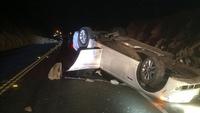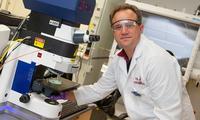-
Roadmap outlines R&D path to reduce storm impacts
A new measurement science research and development (R&D) roadmap, prepared for the National Institute of Standards and Technology (NIST) over the past two years by a private-sector group of hazard mitigation experts, provides a broad strategic approach and R&D objectives to reduce impacts from windstorms and coastal inundations, including storm surge during hurricanes and tsunamis.
-
-
U.S. corporations aware of current, future water risks
A new survey shows that nearly 60 percent of responding companies — the majority Fortune 500 and publically traded, representing virtually every industry sector — indicated that water is poised negatively to affect business growth and profitability within five years, while more than 80 percent said it will affect their decision on where to locate facilities. This is a stark increase from only five years ago, when water issues affected business growth and profitability for less than 20 percent of responding companies.
-
-
Friday L.A. tremor harbinger of quake worse than the Big One

Seismologists warn that a bigger earthquake along the Puente Hills fault, which produced the 5.1 magnitude tremor in Los Angeles last Friday, could cause more damage to the region than the anticipated “Big One” from the San Andreas Fault located on the outskirts of metropolitan Southern California. A 7.5-magnitude earthquake along the Puente Hills fault could kill 3,000 to 18,000 people and cause up to $250 billion in damages, leaving up to 750,000 people homeless. In contrast, an 8-magnitude earthquake along the San Andreas Fault would result in about 1,800 deaths.
-
-
Using more wood for construction will reduce reliance on fossil fuels
A new study has found that using more wood and less steel and concrete in building and bridge construction would substantially reduce global carbon dioxide emissions and fossil fuel consumption. Despite an established forest conservation theory holding that tree harvesting should be strictly minimized to prevent the loss of biodiversity and to maintain carbon storage capacity, the study shows that sustainable management of wood resources can achieve both goals while also reducing fossil fuel burning.
-
-
New drone-based system improves safety of dealing with nuclear hazards
Hazardous nuclear events have the potential to cause widespread damage to individuals and the environment. Getting close enough to these incidents to accurately assess the problem can be extremely dangerous. Following the incident at the Fukushima power plant in Japan in 2011, for example, helicopter pilots assessing the site were exposed to significant amounts of radiation. Researchers have developed a new system for remote and accurate assessment of dangerous nuclear accident sites.
-
-
Obscure element shows promise for nuclear waste storage

One of the least known elements of the periodic table, californium, may hold the key to the safe and effective long-term storage of nuclear waste, according to new research. The researchers have demonstrated that californium (Cf) has an “amazing” ability to bond and separate other materials, as well as being extremely resistant to radiation damage.
-
-
NIST issues final Joplin tornado report
The National Institute of Standards and Technology (NIST) has released the final report on its technical investigation into the impacts of the 22 May 2011 tornado that struck Joplin, Missouri. The massive storm was the single deadliest tornado in the United States in the sixty years that official records have been kept. The NIST Joplin tornado study was the first to study scientifically a tornado in terms of four key aspects: storm characteristics, building performance, human behavior, and emergency communication — and then assess the impact of each on preventing injury or death.
-
-
The costs of using wind energy, natural gas for electricity virtually equal
The costs of using wind energy and natural gas for electricity are virtually equal when accounting for the full private and social costs of each, making wind a competitive energy source for the United States, according to a new study on the federal tax credit for wind energy. The analysis shows that wind energy comes within .35 cents per kWh when levelized over the 20-year life of a typical wind contract, compared on an equivalent basis to the full costs for natural gas-fired energy.
-
-
Russia leads, U.S. lags in construction of nuclear power reactors around the world
Has a new cold war developed between Russian and the United States in the twenty-first century? Many argue that it has — but with a more unconventional front of commercial nuclear energy contracts with developing countries. Russian companies are building 37 percent of new nuclear reactors around the world; U.S. companies build only 7 percent of new nuclear facilities.
-
-
Delaware launches cyber initiative
Delaware is joining the number of states that have decided to invest in a statewide cybersecurity workforce to combat the growing threat of cyberattacks directed at both private and public institutions.Delaware hopes its cyber initiative will accelerate current efforts to develop a stronger cyber workforce. The Delaware Cyber Initiative proposes $3 million for a collaborative learning and research network in the form of part research lab, part business park, dedicated to cyber innovation.
-
-
West Virginia chemical spill degrades air, water quality
In the more than two months since the 9 January chemical spill into West Virginia’s Elk River, new findings reveal the nature of the chemicals that were released into the water and then into the air in residents’ houses. The lack of data motivated researchers to take on essential odor-related research that went beyond their National Science Foundation Rapid Response Research grant to better understand the properties of the chemical mixture called crude 4-methylcyclohexane methanol, the major component in the crude mix of the spilled chemicals into the Elk River
-
-
World record in high altitude wind turbine set to be broken
Boston, Massachusetts-based Altaeros Energies, a wind energy company formed out of MIT, said its Alaska demonstration project is set to break the world record for the highest wind turbine ever deployed. The $1.3 million, 18-month project will deploy the Altaeros BAT at a height 1,000 feet above ground. At that height, the BAT commercial-scale pilot project in Alaska will be over 275 feet taller than the current record holder for the highest wind turbine, the Vestas V164-8.0-MW. Investment into the high altitude wind sector has recently gained momentum with several large acquisitions.
-
-
Quantum mechanics may lead to ultra-secure Internet
In 1935 Einstein and researchers highlighted a “spooky” theory in quantum mechanics, which is the strange way entangled particles stay connected even when separated by large distances. In the 1990s, scientists realized you can securely transmit a message through encrypting and using a shared key generated by Einstein’s strange entanglement to decode the message from the sender and receiver. Using the quantum key meant the message was completely secure from interception during transmission.
-
-
Conflicting views hamper N.C. preparation for sea level rise
Residents of North Carolina’s coastal towns are finding themselves increasingly caught in the cross-fire between local and state government regarding how to define future sea level rise resulting from global warming and the necessary measures needed to prepare for it. Due to a four-year moratorium on any action on the state level, area developers and homeowners have received no official input, and the lack of consensus has negative consequences for the health and prosperity of the region.
-
-
Making the grid smarter makes it more vulnerable to hackers
The U.S. electric grid is constantly under attack despite attempts by utilities to boost physical security and cyberdefenses. In 2013 a DHS cyber emergency team responded to more than eighty incidents involving energy companies. “If you’re a utility today, depending on your scale, you’re under attack at this moment,” says Robert Weisenmiller, chairman of the California Energy Commission.
-
More headlines
The long view
Helping Strengthen America’s Critical Infrastructure
Everyday life depends on a robust infrastructure network that provides access to running water, communications technology and electricity, among other basic necessities. The experts who keep our national infrastructure secure and resilient also need a strong network to share their knowledge and train the next generation of professionals capable of solving complex infrastructure challenges.
AI and the Future of the U.S. Electric Grid
Despite its age, the U.S. electric grid remains one of the great workhorses of modern life. Whether it can maintain that performance over the next few years may determine how well the U.S. competes in an AI-driven world.
Using Liquid Air for Grid-Scale Energy Storage
New research finds liquid air energy storage could be the lowest-cost option for ensuring a continuous power supply on a future grid dominated by carbon-free but intermittent sources of electricity.
Enhanced Geothermal Systems: A Promising Source of Round-the-Clock Energy
With its capacity to provide 24/7 power, many are warming up to the prospect of geothermal energy. Scientists are currently working to advance human-made reservoirs in Earth’s deep subsurface to stimulate the activity that exists within natural geothermal systems.
Experts Discuss Geothermal Potential
Geothermal energy harnesses the heat from within Earth—the term comes from the Greek words geo (earth) and therme (heat). It is an energy source that has the potential to power all our energy needs for billions of years.
